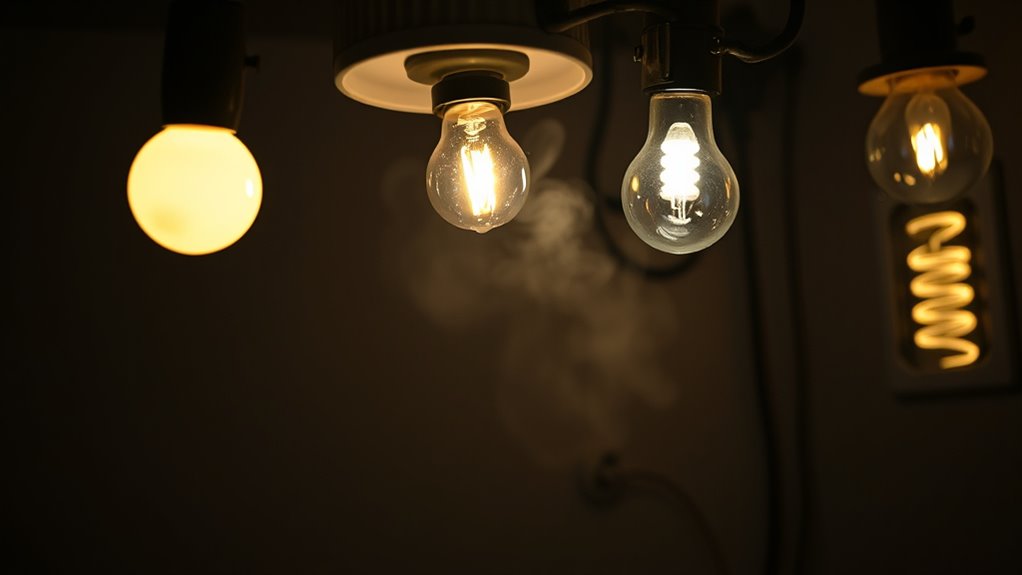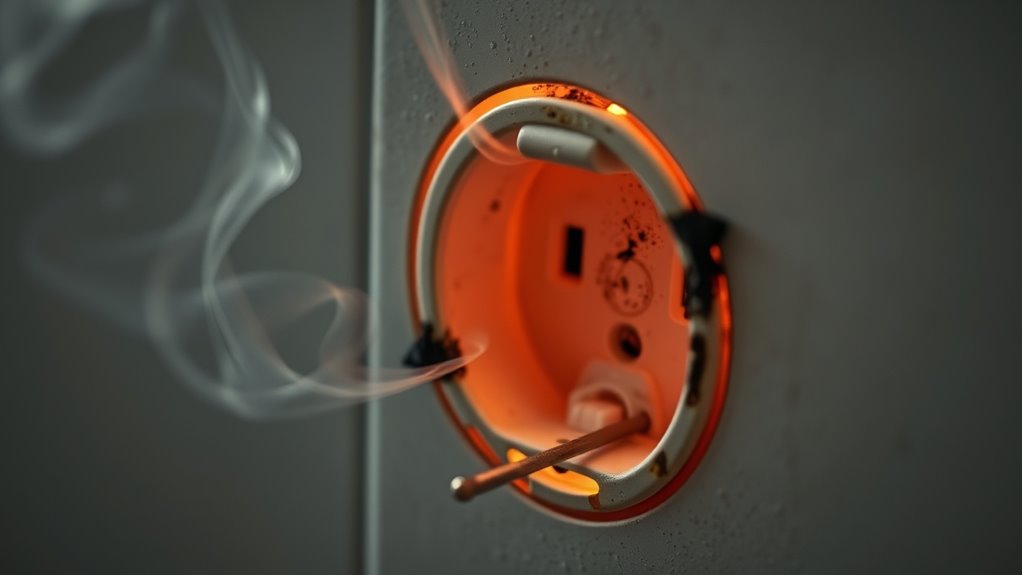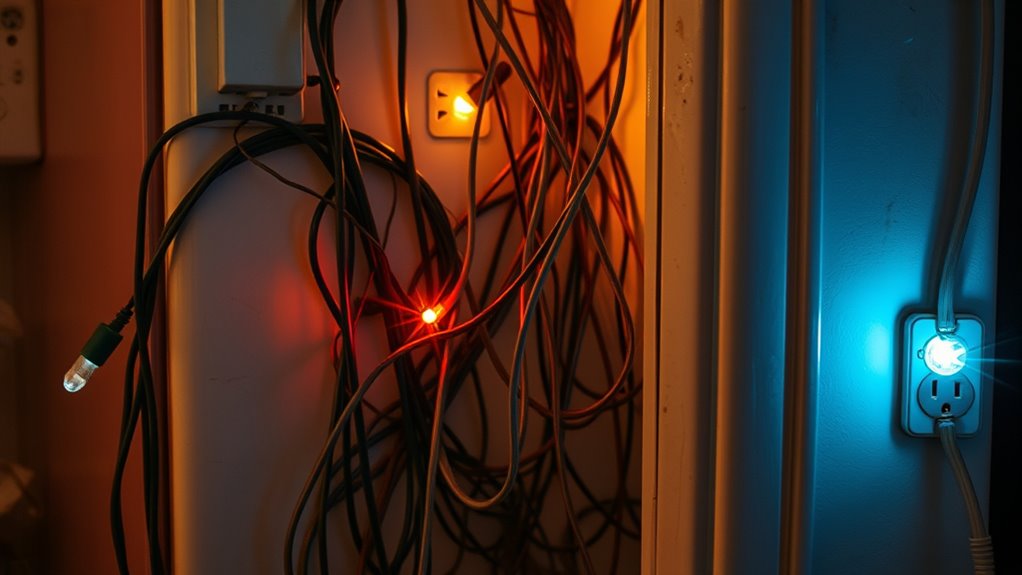When a neutral fails, you might notice flickering or dimming lights, unexpected power surges, or appliances turning on and off suddenly. You could also hear buzzing sounds, experience voltage fluctuations across outlets, or detect burning smells and overheated outlets. Circuit breakers may trip frequently, and wiring might show damage or discoloration. These weird signs indicate serious issues that could lead to hazards. Stay alert—if these symptoms sound familiar, there’s more to understand about protecting your home.
Key Takeaways
- Flickering or dimming lights indicate unstable current caused by a failing neutral connection.
- Unexpected voltage surges or dips can lead to appliance malfunctions and indicate neutral issues.
- Appliances turning on/off randomly or overheating outlets signal potential neutral or wiring faults.
- Persistent buzzing or humming sounds in electrical devices often point to neutral failure or poor grounding.
- Frequent circuit breaker trips or electrical noise across outlets suggest wiring problems linked to neutral failure.
Flickering or Dimming Lights

If your lights flicker or dim unexpectedly, it could indicate a problem with your electrical system. This issue often affects your lighting design, causing inconsistent illumination that disrupts the room’s ambiance. Dimming lights can also signal energy efficiency problems, as they may result from poor wiring or a failing neutral connection. When the neutral fails, current flow becomes unstable, leading to flickering or dimming. This not only impacts your lighting but can also strain your electrical devices. Addressing this early helps maintain a safe, reliable system and preserves the quality of your lighting design. Ensuring proper wiring and a healthy neutral connection keeps your lights steady, improves energy efficiency, and avoids more serious electrical issues down the line. Additionally, having a home security system in place can alert you to electrical irregularities or outages promptly, further safeguarding your home. Modern security systems often include features that monitor electrical faults, providing an extra layer of protection. Regular inspections and maintenance of your electrical system can help detect signs of wiring issues early before they cause more significant problems.
Unexpected Electrical Surges or Spikes

Unexpected electrical surges or spikes can occur suddenly, causing sudden increases in voltage that may damage your appliances and electronics. These surges are often triggered by power grid anomalies, like sudden fluctuations or interruptions, which can happen during heavy storms or equipment failures. Lightning strikes are another common cause, sending powerful bursts of electricity through the wiring. When these surges happen, your devices receive more voltage than they’re designed to handle, risking damage or even complete failure. If you notice your electronics turning off unexpectedly or experiencing irregular behavior after a storm, a surge might be the culprit. Installing surge protectors can help block these damaging spikes, but persistent issues could indicate a more serious electrical problem, such as a neutral failure. Additionally, understanding power grid anomalies can help you better prepare for unexpected surges. Recognizing early warning signs, such as flickering lights or frequent breaker trips, can also help you identify potential electrical system issues before they cause extensive damage. Regular maintenance of your electrical system can reduce the risk of neutral failures and other anomalies that lead to surges. Being aware of dog names is not directly related, but choosing a name that reflects the temperament or appearance of your pet can be part of your preparedness for new pet ownership.
Furthermore, knowing how power quality impacts your electrical system can help you implement better safeguards against surges and protect your home’s electrical integrity.
Appliances Turning On or Off Sporadically

You might notice your appliances turning on or off unexpectedly, and voltage fluctuations could be be the cause. Sudden surges or dips in power can trigger these erratic behaviors. Understanding how these fluctuations influence your devices helps you identify the real problem behind the sporadic operation. Digital literacy programs can equip you with knowledge to better recognize electrical issues and safety concerns related to power instability. For example, recognizing signs that indicate voltage fluctuations can help you take appropriate precautions to protect your devices. Additionally, implementing home electrical safety practices can reduce the risk of damage caused by unstable power supply. Being aware of power quality issues can further assist in diagnosing and addressing these unpredictable appliance behaviors.
Voltage Fluctuations Causing Surges
Voltage fluctuations can cause appliances to turn on or off suddenly, leading to sporadic operation and potential damage. These surges often result from power grid instability or electrical transformer issues, which disrupt consistent voltage flow. When voltage spikes unexpectedly, your devices may flicker or shut down unexpectedly, risking damage over time. To understand the impact, consider this:
| Cause | Effect |
|---|---|
| Power grid instability | Fluctuating voltage levels |
| Electrical transformer issues | Sudden surges or dips in voltage |
These fluctuations can mimic neutral failures, making it tricky to diagnose. Keep an eye on irregular appliance behavior, especially during peak load times or after power outages, as these are signs of underlying voltage surges caused by instability or transformer problems. Proper system sizing and regular inspections can help mitigate these issues.
Unexpected Power Cycle Triggers
Fluctuations in voltage caused by grid instability or transformer issues often lead to appliances turning on or off unexpectedly. A faulty neutral ground can cause inconsistent voltage levels, triggering power cycles in connected devices. When the neutral isn’t properly grounded or is loose, it creates a path for unpredictable current flow, causing appliances to sporadically power on or shut down. Circuit miswiring exacerbates this problem, as incorrect connections can send fluctuating voltage signals to your appliances. These irregularities may seem like random triggers, but they’re often signs of underlying wiring issues. To fix this, you should have a qualified electrician inspect your system for neutral ground faults or circuit miswiring. Addressing these problems prevents unexpected power cycles and protects your devices from damage. Additionally, understanding reliable backup power options can help ensure your home remains powered during such issues.
Unusual Buzzing or Humming Sounds

You might notice a persistent buzzing or humming sound coming from your electrical system, which can be a sign of a neutral failure. These noises often fluctuate intermittently, making it harder to pinpoint the source. Ignoring these signals could lead to more serious electrical issues down the line. Additionally, data privacy challenges can complicate how such electrical issues are monitored and addressed, especially with increasing reliance on smart systems. Furthermore, understanding the electrical safety implications is crucial to prevent potential hazards. Recognizing symptoms like unusual noises can also be linked to self watering plant pots, which often include sensors and electronic components that require proper electrical functioning to operate safely and effectively. Being aware of these symptoms and understanding their causes is essential for maintaining electrical system integrity and avoiding costly repairs.
Persistent Electrical Noise
Persistent electrical noise, such as an unusual buzzing or humming sound, can be a clear sign that your neutral connection isn’t functioning properly. This noise often results from electrical interference or static interference caused by a failing neutral. You might notice the sound persists even when appliances are turned off or fluctuates unexpectedly. To better understand potential causes, consider this table:
| Symptom | Possible Cause |
|---|---|
| Constant buzzing sound | Neutral failure causing interference |
| Humming increases at night | Electrical interference from nearby sources |
| Static interference on devices | Poor grounding or loose connections |
Additionally, proper grounding is essential for electrical safety and can help prevent these issues from escalating. Ensuring your electrical system has the correct neutral wiring can significantly reduce the risk of persistent noise. Regular maintenance and inspections can help identify early warning signs before more serious problems develop. It’s also important to be aware that electrical interference can originate from external sources, such as nearby power lines or equipment, which may require specialized solutions. If these signs appear, it’s vital to have an electrician inspect your wiring. Ignoring persistent electrical noise can lead to more severe electrical issues or safety hazards.
Intermittent Sound Fluctuations
Have you noticed the buzzing or humming sounds that come and go unexpectedly? These intermittent sound fluctuations often point to power grid anomalies or signal interference issues. When the neutral connection is compromised, fluctuations in voltage can cause equipment to produce irregular buzzing or humming noises. These sounds may seem random, but they’re usually linked to fluctuations in the electrical supply or external interference. You might hear the noise intensify when nearby appliances switch on or off, or during times of high demand on the power grid. Signal interference from nearby electronics or faulty wiring can also contribute. Additionally, Jack can sometimes be associated with certain electrical issues that cause such fluctuations. Recognizing the importance of a secure electrical connection can help prevent potential hazards and equipment damage. If these sounds persist or worsen, it’s a sign that your neutral connection might be failing, and you should get a professional inspection to prevent further electrical problems.
Voltage Fluctuations in Multiple Outlets

Ever wonder why your devices sometimes flicker or behave unpredictably across different outlets? Voltage fluctuations in multiple outlets can signal underlying problems like grounding issues or wiring faults. When the neutral connection fails, it can cause inconsistent voltage levels, leading to flickering lights or erratic device operation. Grounding issues may allow stray currents to flow, amplifying voltage swings. Wiring faults, such as loose or damaged connections, can also disrupt voltage stability across your outlets. These problems don’t just cause inconvenience—they can damage sensitive electronics or pose safety hazards. If you notice varying performance or flickering across outlets, it’s essential to have a professional inspect your wiring and grounding systems. Addressing these issues promptly can prevent further damage and ensure your home’s electrical safety.
Burning Smell or Overheating Outlets

A burning smell or overheating outlets are clear signs that something is wrong with your electrical system. If you notice either, don’t overlook it—this poses serious risks to your circuit safety. Overheating outlets can indicate loose connections, overloaded circuits, or damaged wiring, all of which require immediate attention. Regular electrical maintenance helps prevent these issues by catching faults early. Never attempt to fix wiring problems yourself; instead, contact a licensed electrician. Ignoring signs like a burning smell can lead to electrical fires or damage to your appliances. Always prioritize safety by inspecting outlets regularly and addressing any unusual heat or odors promptly. Proper electrical maintenance ensures your home stays safe and reduces the risk of costly repairs down the line.
Persistent Circuit Breaker Trips

Persistent circuit breaker trips can be more than just an annoyance—they’re a warning sign that your electrical system is overloaded or faulty. You might notice frequent trips when using certain outlets or appliances, indicating deeper issues. Common causes include ground faults, where current leaks to the ground, or wiring corrosion, which damages connections and causes instability. To troubleshoot, consider these points:
Persistent breaker trips signal underlying electrical issues like ground faults or wiring corrosion.
- Check for signs of grounding issues or ground faults
- Inspect wiring for corrosion or damage
- Avoid overloading circuits with too many devices
- Ensure breakers are properly rated for your system
- Call a professional if trips persist or if you suspect wiring or ground faults
Ignoring these signs can lead to electrical fires or damage. Addressing persistent trips promptly keeps your system safe.
Electrical Appliances Not Operating Properly

When electrical appliances stop working properly, it often signals underlying issues with your electrical system or the appliances themselves. You might notice your fridge, microwave, or other devices flickering, failing to turn on, or shutting off unexpectedly. These symptoms can compromise your home safety if left unchecked, as faulty wiring or a failing neutral can cause electrical surges or shorts. Regular appliance maintenance helps identify potential problems early, preventing damage and ensuring safety. If appliances frequently malfunction, it’s wise to have an electrician inspect your system. Ignoring these signs could lead to further risks, including fire hazards or appliance damage. Staying attentive to how your appliances operate is key to maintaining a safe, efficient home environment.
Visible Damage or Discoloration on Wiring

Visible damage or discoloration on wiring often signals a serious electrical issue that requires immediate attention. When you notice this, check for compromised wire insulation, which can expose conductors and increase shock risk. Discoloration, such as blackened or brown areas, indicates overheating, often caused by loose connections or conductor corrosion.
Look out for these signs:
- Frayed or melted wire insulation
- Darkened or burnt spots on wiring
- Corrosion around wire terminals
- Discoloration on insulation surfaces
- Visible corrosion on conductors or connectors
These issues can cause shorts, electrical fires, or appliance failure. Addressing them promptly helps prevent further damage and safety hazards. If unsure, always consult a licensed electrician to handle wiring repairs safely.
Frequently Asked Questions
Can a Faulty Neutral Cause Electrical Fires?
Yes, a faulty neutral can cause electrical fires. When the neutral wire malfunctions, it can lead to grounding issues and wiring hazards, creating unstable electrical currents. These irregularities increase the risk of overheating and sparks, which may ignite nearby materials. You should always address neutral problems promptly to prevent potential fire hazards and guarantee your electrical system remains safe. Regular inspections help catch issues before they become dangerous.
How Does a Bad Neutral Affect Sensitive Electronics?
A bad neutral acts like a mischievous ghost, haunting your electronics with grounding issues and voltage fluctuations. When the neutral fails, sensitive electronics suffer from inconsistent power, risking damage or data loss. You might notice flickering screens, unexpected shutdowns, or erratic performance. This unstable environment can fry delicate circuits, making it essential to get your wiring checked immediately. Don’t let a faulty neutral turn your tech sanctuary into a haunted house.
Is It Safe to Use Appliances During Neutral Failure?
You shouldn’t use appliances during a neutral failure because it can cause grounding issues and pose safety risks. A neutral failure disrupts the electrical system, potentially leading to shocks or damage to sensitive electronics. Before using any appliances, you should get a wiring inspection to identify and fix the neutral problem. Avoid risks by having a professional check your wiring and verify everything is safe to operate.
What Are the Long-Term Risks of Ignoring Neutral Issues?
Ignoring neutral issues can lead to serious long-term risks like grounding issues and circuit imbalance, which compromise your safety. Over time, these problems increase the chances of electrical shocks, fires, and damage to your appliances. You might not notice the symptoms right away, but neglecting them can cause costly repairs or dangerous situations. Always address neutral problems promptly to keep your electrical system safe and functioning properly.
How Can I Identify a Neutral Problem Before Symptoms Appear?
You can spot neutral problems early by paying attention to grounding issues and circuit imbalances. If your outlets feel warm, flickering lights occur, or electronic devices behave strangely, these are signs of underlying neutral issues. Regularly inspect your electrical system and use a multimeter to check for voltage irregularities. Catching grounding issues early helps prevent more serious problems and keeps your electrical system safe and reliable.
Conclusion
Understanding these weird electrical symptoms can save you from costly repairs or fire hazards. Did you know that faulty neutral connections are responsible for over 15% of residential electrical fires? By paying attention to signs like flickering lights or buzzing sounds, you can catch problems early. Stay vigilant, get your wiring checked regularly, and keep your home safe. A little awareness now can prevent big headaches later!









